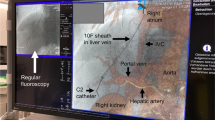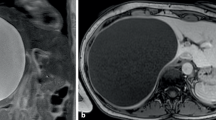Abstract
This CIRSE Standards of Practice document is aimed at interventional radiologists and provides best practices for performing percutaneous transhepatic cholangiography, biliary drainage and stenting. It has been developed by an expert writing group established by the CIRSE Standards of Practice Committee.
Similar content being viewed by others
Abbreviations
- CBD:
-
Common bile duct
- CM:
-
Contrast media
- CT:
-
Computed tomography
- ERC:
-
Endoscopic retrograde cholangiography
- MDCT:
-
Multidetector-row CT
- MRCP:
-
Magnetic resonance cholangiopancreatography
- MRI:
-
Magnetic resonance imaging
- PTC:
-
Percutaneous transhepatic cholangiography
- PTBD:
-
Percutaneous transhepatic biliary drainage
- PTBB:
-
Percutaneous transhepatic biliary balloon dilation
- PTBS:
-
Percutaneous transhepatic biliary stenting
- US:
-
Ultrasound
References
Walter T, Ho CS, Horgan AM, et al. Endoscopic or percutaneous biliary drainage for Klatskin tumors? J Vasc Interv Radiol. 2013;24(1):113–21.
Ahmed O, Mathevosian S, Arslan B. Biliary interventions: tools and techniques of the trade, access, cholangiography, biopsy, cholangioscopy, cholangioplasty, stenting, stone extraction, and brachytherapy. Semin Intervent Radiol. 2016;33(4):283–90.
Denzer U, Beilenhoff U, Eickhoff A, et al. S2k guideline: quality requirements for gastrointestinal endoscopy, AWMF registry no. 021–022. Z Gastroenterol. 2015;53(12):1496–530.
Krokidis M, Hatzidakis A. Percutaneous minimally invasive treatment of malignant biliary strictures: current status. Cardiovasc Intervent Radiol. 2014;37(2):316–23.
Radosa C, Schaab F, Hofmockel T, Kühn JP, Hoffmann RT. Percutaneous biliary and gallbladder interventions. Radiologe. 2019;59(4):342–7.
Saad WE, Wallace MJ, Wojak JC, Kundu S, Cardella JF. Quality improvement guidelines for percutaneous transhepatic cholangiography, biliary drainage, and percutaneous cholecystostomy. J Vasc Interv Radiol. 2010;21(6):789–95.
Faithfull GR, Smith RC, Manap NA. Percutaneous transhepatic biliary drainage for obstructive jaundice. Med J Aust. 1982;1(6):269–77.
Riemann JF, Lux G, Rösch W, Beickert-Sterba A. Non-surgical biliary drainage - technique, indications and results. Endoscopy. 1981;13(4):157–61.
Rees J, Mytton J, Evison F, Mangat KS, Patel P, Trudgill N. The outcomes of biliary drainage by percutaneous transhepatic cholangiography for the palliation of malignant biliary obstruction in England between 2001 and 2014: a retrospective cohort study. BMJ Open. 2020;10(1):e033576.
Janssen JJ, van Delden OM, van Lienden KP, et al. Percutaneous balloon dilatation and long-term drainage as treatment of anastomotic and nonanastomotic benign biliary strictures. Cardiovasc Intervent Radiol. 2014;37(6):1559–67.
Kucukay F, Okten RS, Yurdakul M, et al. Long-term results of percutaneous biliary balloon dilation treatment for benign hepaticojejunostomy strictures: are repeated balloon dilations necessary? J Vasc Interv Radiol. 2012;23(10):1347–55.
Chehab MA, Thakor AS, Tulin-Silver S, et al. Adult and Pediatric antibiotic prophylaxis during vascular and ir procedures: a society of interventional radiology practice parameter update endorsed by the cardiovascular and interventional radiological society of europe and the canadian association for interventional radiology. J Vasc Interv Radiol. 2018;29(11):1483-1501.e1482.
Davidson JC, Rahim S, Hanks SE, et al. Society of interventional radiology consensus guidelines for the periprocedural management of thrombotic and bleeding risk in patients undergoing percutaneous image-guided interventions-part I: review of anticoagulation agents and clinical considerations: endorsed by the canadian association for interventional radiology and the cardiovascular and interventional radiological society of europe. J Vasc Interv Radiol. 2019;30(8):1155–67.
Romagnoli S, Fanelli F, Barbani F, et al. CIRSE standards of practice on analgesia and sedation for interventional radiology in adults. Cardiovasc Intervent Radiol. 2020;43(9):1251–60.
Lee MJ, Fanelli F, Haage P, Hausegger K, Van Lienden KP. Patient safety in interventional radiology: a CIRSE IR checklist. Cardiovasc Intervent Radiol. 2012;35(2):244–6.
Giurazza F, Corvino F, Contegiacomo A, et al. Safety and effectiveness of ultrasound-guided percutaneous transhepatic biliary drainage: a multicenter experience. J Ultrasound. 2019;22(4):437–45.
Wagner A, Mayr C, Kiesslich T, Berr F, Friesenbichler P, Wolkersdörfer GW. Reduced complication rates of percutaneous transhepatic biliary drainage with ultrasound guidance. J Clin Ultrasound. 2017;45(7):400–7.
Taslakian B, Ingber R, Aaltonen E, Horn J, Hickey R. Interventional radiology suite: a primer for trainees. J Clin Med. 2019;8(9):1347.
Boos J, Yoo RJ, Steinkeler J, et al. Fluoroscopic percutaneous brush cytology, forceps biopsy and both in tandem for diagnosis of malignant biliary obstruction. Eur Radiol. 2018;28(2):522–9.
Li Z, Li TF, Ren JZ, et al. Value of percutaneous transhepatic cholangiobiopsy for pathologic diagnosis of obstructive jaundice: analysis of 826 cases. Acta Radiol. 2017;58(1):3–9.
Mehmood S, Loya A, Yusuf MA. Biliary brush cytology revisited. Acta Cytol. 2016;60(2):167–72.
Navaneethan U, Njei B, Lourdusamy V, Konjeti R, Vargo JJ, Parsi MA. Comparative effectiveness of biliary brush cytology and intraductal biopsy for detection of malignant biliary strictures: a systematic review and meta-analysis. Gastrointest Endosc. 2015;81(1):168–76.
Schmitz D, Vogl T, Nour-Eldin NA, et al. Patient radiation dose in percutaneous biliary interventions: recommendations for DRLs on the basis of a multicentre study. Eur Radiol. 2019;29(7):3390–400.
Liu YS, Lin CY, Chuang MT, Tsai YS, Wang CK, Ou MC. Success and complications of percutaneous transhepatic biliary drainage are influenced by liver entry segment and level of catheter placement. Abdom Radiol (NY). 2018;43(3):713–22.
Choi SH, Gwon DI, Ko GY, et al. Hepatic arterial injuries in 3110 patients following percutaneous transhepatic biliary drainage. Radiology. 2011;261(3):969–75.
Fidelman N, Bloom AI, Kerlan RK Jr, et al. Hepatic arterial injuries after percutaneous biliary interventions in the era of laparoscopic surgery and liver transplantation: experience with 930 patients. Radiology. 2008;247(3):880–6.
Garcarek J, Kurcz J, Guziński M, Janczak D, Sasiadek M. Ten years single center experience in percutaneous transhepatic decompression of biliary tree in patients with malignant obstructive jaundice. Adv Clin Exp Med. 2012;21(5):621–32.
Kim SH, Zangan SM. Percutaneous transhepatic biliary drainage complicated by bilothorax. Semin Intervent Radiol. 2015;32(1):54–6.
Nennstiel S, Weber A, Frick G, et al. Drainage-related complications in percutaneous transhepatic biliary drainage: an analysis over 10 years. J Clin Gastroenterol. 2015;49(9):764–70.
Quencer KB, Tadros AS, Marashi KB, et al. Bleeding after percutaneous transhepatic biliary drainage: incidence Causes and Treatments. J Clin Med. 2018;7(5):94.
Yamashita H, Ebata T, Yokoyama Y, et al. Pleural dissemination of cholangiocarcinoma caused by percutaneous transhepatic biliary drainage during the management of resectable cholangiocarcinoma. Surgery. 2019;165(5):912–7.
Ignee A, Cui X, Schuessler G, Dietrich CF. Percutaneous transhepatic cholangiography and drainage using extravascular contrast enhanced ultrasound. Z Gastroenterol. 2015;53(5):385–90.
Kühn JP, Busemann A, Lerch MM, Heidecke CD, Hosten N, Puls R. Percutaneous biliary drainage in patients with nondilated intrahepatic bile ducts compared with patients with dilated intrahepatic bile ducts. AJR Am J Roentgenol. 2010;195(4):851–7.
Uberoi R, Das N, Moss J, Robertson I. British society of interventional radiology: biliary drainage and stenting registry (BDSR). Cardiovasc Intervent Radiol. 2012;35(1):127–38.
Gupta P, Maralakunte M, Rathee S, et al. Percutaneous transhepatic biliary drainage in patients at higher risk for adverse events: experience from a tertiary care referral center. Abdom Radiol. 2019;45(8):2547–53.
Weber A, Gaa J, Rosca B, et al. Complications of percutaneous transhepatic biliary drainage in patients with dilated and nondilated intrahepatic bile ducts. Eur J Radiol. 2009;72(3):412–7.
Ko GY, Sung KB, Yoon HK, Kim KR, Gwon DI, Lee SG. Percutaneous transhepatic treatment of hepaticojejunal anastomotic biliary strictures after living donor liver transplantation. Liver Transpl. 2008;14(9):1323–32.
Morita S, Kitanosono T, Lee D, et al. Comparison of technical success and complications of percutaneous transhepatic cholangiography and biliary drainage between patients with and without transplanted liver. AJR Am J Roentgenol. 2012;199(5):1149–52.
Funaki B, Zaleski GX, Straus CA, et al. Percutaneous biliary drainage in patients with nondilated intrahepatic bile ducts. AJR Am J Roentgenol. 1999;173(6):1541–4.
Castiglione D, Gozzo C, Mammino L, Failla G, Palmucci S, Basile A. Health-Related Quality of Life evaluation in “left” versus “right” access for percutaneous transhepatic biliary drainage using EORTC QLQBIL-21 questionnaire: a randomized controlled trial. Abdom Radiol (NY). 2020;45(4):1162–73.
Nennstiel S, Treiber M, Faber A, et al. Comparison of ultrasound and fluoroscopically guided percutaneous transhepatic biliary drainage. Dig Dis. 2019;37(1):77–86.
Krokidis M, Orgera G, Fanelli F, Hatzidakis A. Covered biliary metal stents: which, where, when? Gastrointest Endosc. 2011;74(5):1173–4.
Krokidis M, Fanelli F, Orgera G, Bezzi M, Passariello R, Hatzidakis A. Percutaneous treatment of malignant jaundice due to extrahepatic cholangiocarcinoma: covered viabil stent versus uncovered wallstents. Cardiovasc Intervent Radiol. 2010;33(1):97–106.
Dhondt E, Vanlangenhove P, Geboes K, Vandenabeele L, Van Cauwenberghe L, Defreyne L. No evidence of improved efficacy of covered stents over uncovered stents in percutaneous palliation of malignant hilar biliary obstruction: results of a prospective randomized trial. Eur Radiol. 2020;30(1):175–85.
Lee E, Gwon DI, Ko GY, et al. Percutaneous biliary covered stent insertion in patients with malignant duodenobiliary obstruction. Acta Radiol. 2015;56(2):166–73.
Cantwell CP, Pena CS, Gervais DA, Hahn PF, Dawson SL, Mueller PR. Thirty years’ experience with balloon dilation of benign postoperative biliary strictures: long-term outcomes. Radiology. 2008;249(3):1050–7.
Yun G, Yoon CJ, Seong NJ. Percutaneous treatment of benign bilioenteric anastomotic strictures: temporary covered stent placement versus balloon dilatation. Eur Radiol. 2019;29(5):2690–7.
Saad WE, Davies MG, Saad NE, et al. Transhepatic dilation of anastomotic biliary strictures in liver transplant recipients with use of a combined cutting and conventional balloon protocol: technical safety and efficacy. J Vasc Interv Radiol. 2006;17(5):837–43.
Dama R, SINGH J, Nag P, Rabela P, RAO G, REDDY D. . Percutaneous management of benign hepaticojejunostomy HJ strictures experience at a tertiary referral centre. J Gastroenterol Hepatol. 2011;26:37–47.
Köcher M, Cerná M, Havlík R, Král V, Gryga A, Duda M. Percutaneous treatment of benign bile duct strictures. Eur J Radiol. 2007;62(2):170–4.
Vos PM, van Beek EJ, Smits NJ, Rauws EA, Gouma DJ, Reeders JW. Percutaneous balloon dilatation for benign hepaticojejunostomy strictures. Abdom Imaging. 2000;25(2):134–8.
Mauri G, Michelozzi C, Melchiorre F, et al. Biodegradable biliary stent implantation in the treatment of benign bilioplastic-refractory biliary strictures: preliminary experience. Eur Radiol. 2013;23(12):3304–10.
Saad WE. Percutaneous management of postoperative anastomotic biliary strictures. Tech Vasc Interv Radiol. 2008;11(2):143–53.
Funding
This study was not supported by any funding.
Author information
Authors and Affiliations
Corresponding author
Ethics declarations
Conflict of interest
All authors declare that they do not have any conflict of interest.
Ethical Approval
For this type of study, informed consent is not required.
Additional information
Publisher's Note
Springer Nature remains neutral with regard to jurisdictional claims in published maps and institutional affiliations.
Definitions
- Percutaneous transhepatic cholangiography (PTC)
-
PTC is a diagnostic procedure for imaging of the biliary system. It is mainly performed when cross-sectional imaging is not sufficient for diagnosis. Contrast media (CM), usually iodinated CM, is injected into a bile duct after percutaneous puncture of a peripheral duct. Diagnostic images are obtained by fluoroscopy in one or more projections. As magnetic resonance cholangiopancreatography (MRCP), US and CT are widely available, diagnostic PTC has become rare. It is now mostly performed as the first step in percutaneous transhepatic biliary drainage.
- Percutaneous transhepatic biliary drainage (PTBD)
-
PTBD is a therapeutic procedure to provide internal or external drainage of the obstructed biliary system. It involves percutaneous puncture of a (peripheral) biliary radicle, followed by fluoroscopic or US guided wire and catheter placement. Often an attempt is made to advance a guide wire into the duodenum (or into the jejunum in surgically altered anatomy), in order to place an external-internal drain. PTBD can involve a right sided or a left sided approach or a combination of both, depending on best access route and underlying pathology.
- Percutaneous biliary balloon dilatation (PBBD)
-
PBBD is a therapeutic procedure for the treatment of biliary strictures using intra ductal balloon dilatation. After percutaneous puncture, the stricture is passed with a guidewire. A balloon is inflated (usually for several minutes) to eliminate or improve the stricture. One PBBD session may require several balloon inflations. Usually a drainage catheter is placed after balloon dilatation at or just above the former stricture site.
- Percutaneous transhepatic biliary stenting (PTBS)
-
This therapeutic procedure is used for temporary or permanent stenting of a biliary stricture in order to restore internal bile drainage. After percutaneous puncture, the stricture is passed with a guidewire. A plastic or metal (un)covered stent is then placed at the site of the stricture.
Rights and permissions
About this article
Cite this article
Das, M., van der Leij, C., Katoh, M. et al. CIRSE Standards of Practice on Percutaneous Transhepatic Cholangiography, Biliary Drainage and Stenting. Cardiovasc Intervent Radiol 44, 1499–1509 (2021). https://doi.org/10.1007/s00270-021-02903-4
Received:
Accepted:
Published:
Issue Date:
DOI: https://doi.org/10.1007/s00270-021-02903-4




